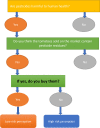Consumer risk perception towards pesticide-stained tomatoes in Uganda
- PMID: 38100496
- PMCID: PMC10723735
- DOI: 10.1371/journal.pone.0247740
Consumer risk perception towards pesticide-stained tomatoes in Uganda
Abstract
Background: Tomatoes are consumed daily. Unfortunately, abuse of pesticide application by vegetable growers in Uganda increases risks of pesticide residue exposure among consumers, as they may be above Maximum Residue Limits (European Union Maximum Residue Limits used as a standard in Uganda). This study aimed to determine consumer attitudes and risk perceptions towards pesticide-stained tomatoes in Uganda to support interventions that could be used to reduce pesticide residue exposures in food.
Methods: A mixed methods cross-sectional study sampled 468 household consumers in four regions of Uganda, selecting one district (interventional project area) per region. In each district, about 60 household members were randomly selected from a total of three Sub Counties and interviewed. In addition, 9 tomato handlers (three tomato farmers, three tomato retailers, and three tomato wholesalers) participated in Focus Group Discussions (FGDs) per district. Collected data were entered into MS-Excel 13 and exported into Stata version 14.0 for cleaning and analysis at a 5% level of significance and 95% Confidence Intervals (CI). The proportion of risk perceptions and attitudes were computed and presented as percentages, while factors associated with risk perception were determined using Fisher exact test. Qualitative data collected under a traditional theory were analyzed using thematic content analysis.
Results: More than half, 54.2% (253/468), of the respondents were females, mean age was 37 years (SD = 13.13, ranging from 18 to 88 years). Half of the respondents, 50.9% (238/467), were farmers by occupation, and 40.3% (188/468) had completed upper primary education. Only 5.0% (20/396) of consumers reported a high-risk perception towards tomatoes stained with pesticide residues, the rest, 95.0% (376/396), were buying pesticide-stained tomatoes despite their awareness of the possible health effects. The main reason for buying the pesticide-stained tomatoes was that a majority, 59.0% (230/390), lacked an alternative to stained tomatoes like organically grown tomatoes. However, consumers generally had a negative attitude towards pesticide-stained tomatoes, with 67.0% (313/468) of the consumers disagreeing with the statement that tomatoes sold on the market are safe. Consumer risk perception was significantly associated with their awareness about residues in the tomatoes; where the proportion of consumers who were aware of the risk of pesticide-stained tomatoes was 42.8 times more likely not to buy stained tomatoes compared to the proportion of those who were not aware. OR, 42.8 (95% CI: 10.76-170.28). However, after Fisher-Exact tests analysis, level of education P(0.975), gender P(0.581), and age group P(0.680) were not associated with consumer risk perception (95% CI and 5% level of significance).
Conclusion: Although the consumers had a negative attitude towards the pesticide-stained tomatoes, their risk perception towards them ranked low, with most consumers buying tomatoes stained with pesticide residues due to a lack of an alternative. Ministry of Agriculture extension service efforts should promote and emphasize community to start household-based organic kitchen gardens as the efforts for the establishment of a national pesticide residue monitoring center awaits.
Copyright: © 2023 Sekabojja et al. This is an open access article distributed under the terms of the Creative Commons Attribution License, which permits unrestricted use, distribution, and reproduction in any medium, provided the original author and source are credited.
Conflict of interest statement
The authors have declared that no competing interests exist.
Figures





Similar articles
-
Dietary risk assessment of selected organophosphorus and pyrethoid pesticide residues in fresh harvested tomatoes at Makambako Town, Njombe region, Tanzania.Food Addit Contam Part B Surveill. 2022 Sep;15(3):235-243. doi: 10.1080/19393210.2022.2056769. Epub 2022 Apr 5. Food Addit Contam Part B Surveill. 2022. PMID: 35382700
-
Consumer Awareness and Health Risk Perceptions of Pesticide Residues in Fruits and Vegetables in Kampala Metropolitan Area in Uganda.Environ Health Insights. 2023 Jul 17;17:11786302231184751. doi: 10.1177/11786302231184751. eCollection 2023. Environ Health Insights. 2023. PMID: 37476078 Free PMC article.
-
Pesticide Residues in Food: Attitudes, Beliefs, and Misconceptions among Conventional and Organic Consumers.J Food Prot. 2017 Dec;80(12):2083-2089. doi: 10.4315/0362-028X.JFP-17-104. J Food Prot. 2017. PMID: 29154718
-
Assessment of Dithiocarbamate Residues on Tomatoes Conventionally Grown in Uganda and the Effect of Simple Washing to Reduce Exposure Risk to Consumers.Environ Health Insights. 2017 Jun 5;11:1178630217712218. doi: 10.1177/1178630217712218. eCollection 2017. Environ Health Insights. 2017. PMID: 28615952 Free PMC article. Review.
-
Consumption of fruits and vegetables contaminated with pesticide residues in Brazil: A systematic review with health risk assessment.Chemosphere. 2023 May;322:138244. doi: 10.1016/j.chemosphere.2023.138244. Epub 2023 Feb 23. Chemosphere. 2023. PMID: 36841459
References
-
- FAO, Codex Pesticides Residues in Food Online Database. 2016, © FAO/WHO, 2019.
-
- WHO. Pesticide residues in food. KEY FACTS 2018 [cited 2019 FEBRUARY,]; Available from: https://www.who.int/en/news-room/fact-sheets/detail/pesticide-residues-i....
-
- Hamilton D., et al.., Pesticide residues in food—acute dietary exposure. Pest Management Science: formerly Pesticide Science, 2004. 60(4): p. 311–339. - PubMed
MeSH terms
Substances
LinkOut - more resources
Full Text Sources
Medical

